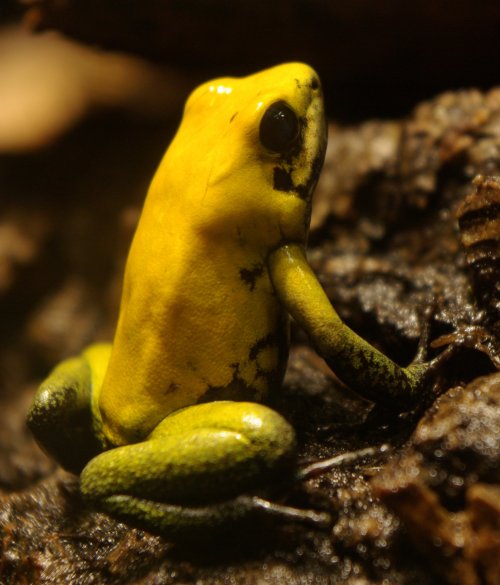- Black-legged Dart Frog
Taxobox
name = "Phyllobates bicolor"
status = NT | status_system = IUCN3.1
trend = down

image_width = 240px
regnum =Animalia
phylum = Chordata
classis =Amphibia
ordo =Anura
subordo =Neobatrachia
familia =Dendrobatidae
genus = "Phyllobates "
species = "P. bicolor"
binomial = "Phyllobates bicolor"
binomial_authority = (Duméril andBibron , 1841)The Black-legged Dart Frog ("Phyllobates bicolor"), also known as the bicolored dart frog or Neari in Choco, is the second most toxic of the wildpoison dart frog s. This species obtained its name due to its normally yellow or orange body with black or dark blue hindlegs and forelimbs below the elbow. It lives in the lowland forests in theChocó area in westernColombia , along the San Juan river, although some populations lives further South in Quebrada Guangui. The frogs from Quebrada Guangui bear a striking resemblance to the yellow or orange forms of "Phyllobates terribilis ", and are sometimes confused for them by hobbyists.In this species, the male transports
tadpole s adhering on its back. [cite book |last=Hickman | first=Cleveland P. Jr., "et al." | authorlink= | title=Integrated Principles of Zoology | publisher=McGraw-Hill New York | year=2006 | doi= | id=]Toxicity
While its toxicity is weaker than "P. terribilis", "Phyllobates bicolor" is still a highly toxic animal. Just 150 micrograms of its poison is enough to kill an adult human. This frog is often heated over a flame to make it "sweat" the liquid poison for hunting darts. The poison causes death by respiratory and muscular paralysis. Research is being conducted to determine medicinal uses for this
batrachotoxin . As with all dart frogs, captive-raised individuals are not toxic; the animals require chemicals found only in their wild food sources, mainly insects. In captivity, these chemicals are not available to them from their food source.Captive care
Care for "P. Bicolor" is similar to "
Phyllobates terribilis ", except "P. bicolor" can be kept in a slightly smaller enclosure. Both males and females of this species can be vocal.References
* Database entry includes a range map and justification for why this species is near threatened
* Olson, E. 2001. "Phyllobates bicolor" (On-line), Animal Diversity Web. Accessed June 09, 2006 at http://animaldiversity.ummz.umich.edu/site/accounts/information/Phyllobates_bicolor.html
Wikimedia Foundation. 2010.
